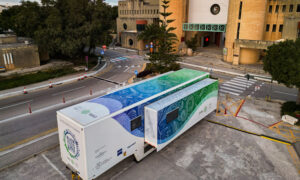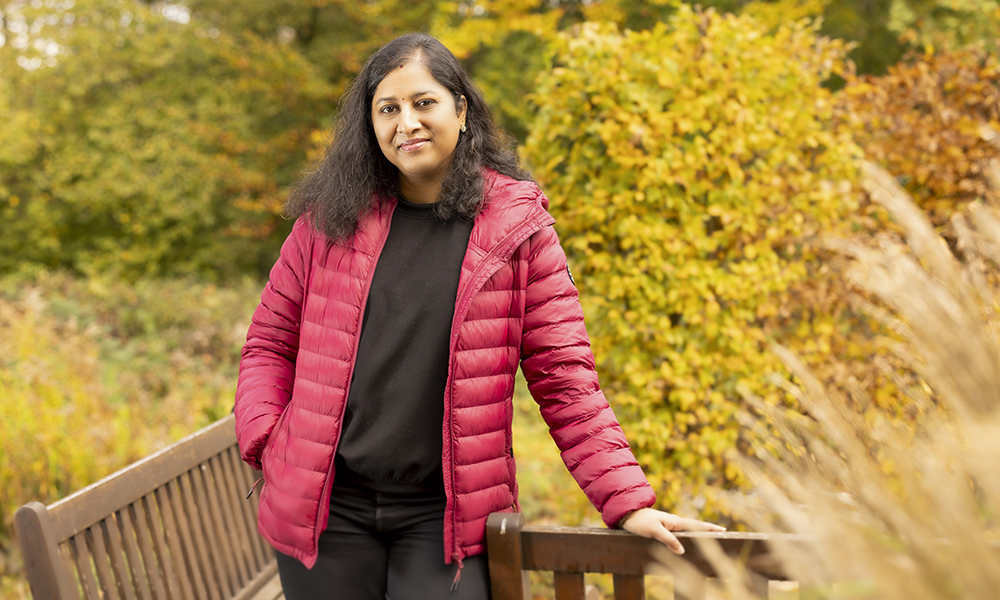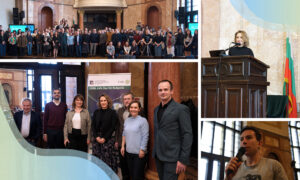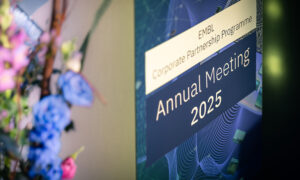
The value of a scientific meet-up
Yuvarani Masarapu, a SciLifeLab PhD fellow, spent a week with EMBL collaborators, finding solutions to research challenges and expanding her scientific perspective

Collaborating with scientists outside your institution is great. But it’s even better when you get to meet in person.
Yuvarani Masarapu, a junior bioinformatician and doctoral student at KTH Royal Institute of Technology and the SciLifeLab in Stockholm, spent a week at EMBL Heidelberg in October, getting to know her collaborators in Georg Zeller’s research group as well as other scientists at Heidelberg University.
She is involved in CartoHostBug, a joint project between EMBL and SciLifeLab that the European Research Council (ERC) awarded in 2023. CartoHostBug will help scientists study the spatial architecture of microbiome-host crosstalk in the human gut, using a combination of novel imaging approaches, spatial transcriptomics technologies, and computational modelling techniques. The research supported by this grant aims to construct the first spatial map of host-microbiome interactions in the human gut, which can potentially provide future insights into diseases such as inflammatory bowel diseases and colorectal cancer.
Masarapu’s visit, enabled by a SciLifeLab travel grant, was not only a professional development opportunity but also a testament to the continuously growing collaboration between the two research organisations.
In 2021, EMBL and SciLifeLab signed a memorandum of understanding based on their shared scientific goals to face global challenges and find effective solutions to improve planetary and human health. Since then, the two organisations have hosted workshops about a range of issues that can expand both organisations’ research capabilities and mindsets, such as data-driven planetary biology, biodiversity, genomics, ecology, evolution, and bioinformatics. Previous SciLlifeLab visitors coming to EMBL on a travel grant have benefitted from EMBL’s broad course and conference offerings or its microscopy expertise. For example, SciLifeLab’s head staff scientist visited EMBL’s Advanced Light Microscopy facility to get hands-on experience with MINFLUX, a cutting-edge fluorescence microscopy technique.
We caught up with Masarapu to find out more about her specific experiences at EMBL.
How did you hear about this opportunity to visit EMBL?
I heard about this fantastic opportunity from Disa Hammarlöf in SciLifeLab communications. I had also seen short articles in the SciLifeLab newsletter about others’ EMBL visits. When this year’s SciLifeLab-EMBL travel grant call was announced, I immediately applied for it. I hoped to exchange ideas and brainstorm with our collaborators at EMBL on different aspects of our CartoHostBug projects.
What kinds of things did you do while at EMBL?
First of all, EMBL is beautiful! There is so much nature and greenery around EMBL, which was so peaceful. That said, I did many exciting things at EMBL. I spent most of my time with our collaborator Fabian Springer from the Zeller group. Fabian has expertise in microbiome research, and since I am a beginner in the field, it was extremely helpful to get his input (in person!) on my ongoing work. I’m using spatial metatranscriptomics data, which let me essentially map active (expressed) genes in a microbial sample. This helps us understand how specific microbes might influence disease or contribute to health, based on their location. I’m still facing some challenges, especially finding a nucleotide reference database that can help with my work – specifically with the 16S gene that is present in nearly all bacteria but can help distinguish between different bacterial species. Fabian and I brainstormed on ways that might potentially help us address this, both now and for future projects.
What was most useful and interesting?
Of course, it was helpful to exchange fruitful scientific ideas with Fabian in person, but it was equally useful and fun to meet the other Zeller lab researchers: Shraddha Shitut, Nicolai Karcher, Laura Bornes, and Maral Baghai Arassi. I learned about the different imaging experiments they are running to target different bacteria from human gut samples. Laura performs some parts of the imaging protocol before Shraddha does the imaging. I am not a wet lab person by training, so watching them in the lab and learning about the imaging protocols were both interesting and fun for me. And on top of this all, I got to tour the EMBL Imaging Centre, which was very cool!
What happens next?
Everything I learned from Fabian, Shraddha, and Laura was relevant to my PhD research. I have already started to apply my new knowledge to current projects. An ERC grant supports our ongoing collaboration with the Zeller group, so the visit further cemented this work and opened the door for future collaborations between SciLifeLab and EMBL.
What are your impressions of EMBL?
I didn’t know a lot about EMBL’s organisational structure, but I thought it might be similar to SciLifeLab. After getting to know EMBL researchers, I learned there’s so much more to EMBL. EMBL’s many talented researchers are able to share extensive experience not just from the wet lab perspective, but also from the computational side. I was impressed by the sense of community among EMBL’s researchers. I have found that this is a valuable quality, as scientific collaborations are key to research development.


